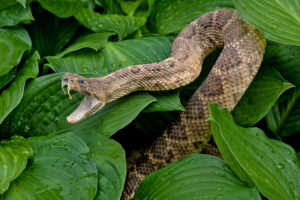Which Snakes in Maryland Are Dangerous
Maryland is known for its diverse ecosystems and stunning natural beauty. It is home to a variety of snake species. While the majority of these snakes are harmless and play crucial roles in maintaining the balance of the ecosystem, it’s important to be aware of the few venomous species that reside in the state. We’ve highlighted the venomous snakes found in Maryland and provided essential information to help you identify and stay safe when encountering them in the wild.

Timber Rattlesnake (Crotalus horridus)
One of the most well-known venomous snakes in Maryland is the timber rattlesnake. Typically found in rocky areas, hardwood forests, and rugged terrain, they can grow up to five feet in length. Their distinctive feature is the rattle at the end of their tail, which they use as a warning sign when feeling threatened. If you encounter a timber rattlesnake, maintain a safe distance and give it space to retreat.
Northern Copperhead (Agkistrodon contortrix mokasen)
The northern copperhead is another venomous snake found in Maryland. These snakes prefer woodland habitats, rocky areas, and riverbanks. They are known for their copper-colored heads and hourglass-like patterns on their bodies. Northern copperheads are generally not aggressive but may strike if they feel threatened or cornered. Keep a safe distance and avoid provoking or handling them.
Eastern Cottonmouth/Water Moccasin (Agkistrodon piscivorus)
Although rare in Maryland, the eastern cottonmouth, also known as the water moccasin, can occasionally be found in the state’s marshes, swamps, and wetlands. They are large, semi-aquatic snakes with distinctive dark coloration and a white mouth lining, which they display as a warning signal when threatened. It is crucial to be cautious around these snakes and avoid any close encounters.
Eastern Coral Snake (Micrurus fulvius)
The eastern coral snake, though rarely encountered, is the most venomous snake in Maryland. However, its population and distribution in the state are limited. These snakes have a striking pattern of red, yellow, and black bands, and they inhabit wooded areas with sandy soils. Due to their reclusive nature, the chances of encountering an eastern coral snake are extremely low. Nevertheless, if you do encounter one, maintain a safe distance and contact local authorities to report the sighting.
General Safety Tips
- Educate yourself: Familiarize yourself with the appearance and habitat of venomous snakes in Maryland. Knowledge is the first line of defense.
- Stay on designated paths: When exploring natural areas, stick to established trails or paths to minimize the risk of accidentally stumbling upon a snake.
- Wear appropriate footwear: When hiking or walking in snake-prone areas, wear closed-toe shoes or boots to protect your feet from potential snake bites.
- Give snakes space: If you encounter a snake, keep a safe distance and do not attempt to handle or provoke it. Remember, most snake bites occur when people try to handle or kill them.
- Stay alert: Be observant of your surroundings and watch for any signs or sounds of snakes. Be cautious when reaching into brush or tall grass.
Stay Safe with Bay Area Wildlife Solutions
While venomous snakes do exist in Maryland, it’s essential to remember that they generally avoid human contact and pose little threat if given proper respect and distance. If you do come into contact with one, call on the experts of Bay Area Wildlife Solutions to help. With our 24/7 emergency support, we’re always here to help remove snakes, skunks, birds, bats, raccoons, and other wildlife that can be dangerous to you and your home. Contact us now to request a consultation.

 302.500.0181
302.500.0181  410.829.6368
410.829.6368